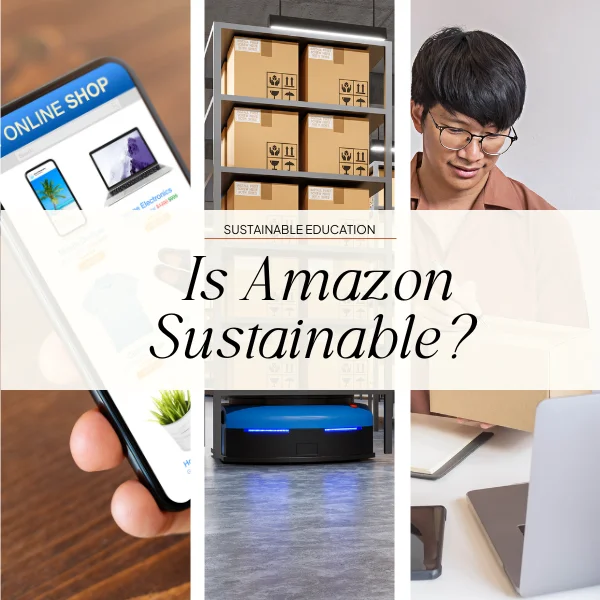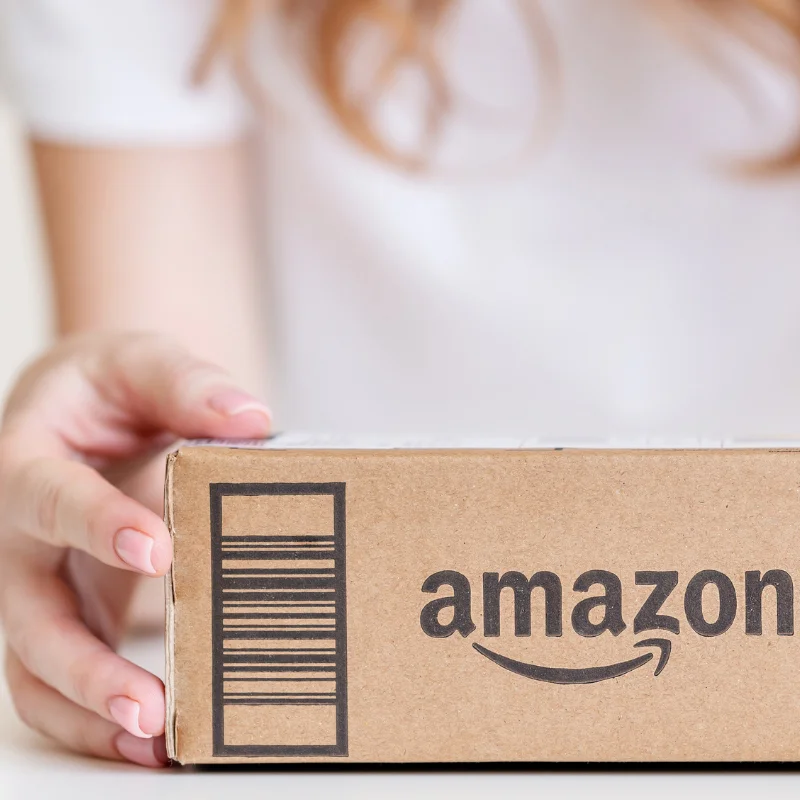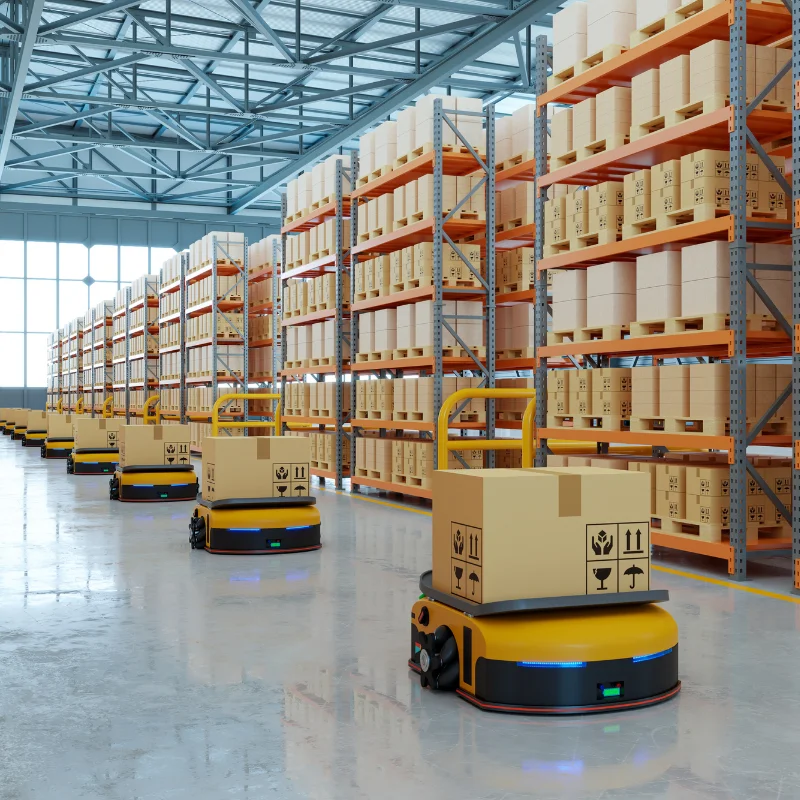SKL is reader supported. When you buy through links on our site, we may earn affiliate commission. Learn more here.
Is Amazon sustainable? Could it ever be a possibility? These are the questions that we are deep diving into today with the help of our lead educational writer, Brooke Bowlin.
With a market value of $1.3 trillion and a 2022 revenue of almost $514 billion, Amazon is a behemoth of a business and has the financial backing and power to do great good or great evil.
Their undeniable influence on culture and the economy is baffling. So what’s up with their environmental and social impact? Let’s dive in.
This blog post is all about the sustainability of Amazon Marketplace.

As the world’s biggest online retailer and a part of the top 5 biggest companies in the world, Amazon holds a lot of power in its ability to have a sizable impact.
Founder Jeff Bezos drew name inspiration from the Amazon River, the largest river and most biodiverse place on Earth. Ironically, “the everything store” and its scale, practices, and cultural influence present threats to the natural world and ecosystems like the Amazon River Basin. Let’s explore how.
How Sustainable is Amazon Really?
You’ll find that the reviews are mixed when it comes to the perception of Amazon’s sustainability.
Some consider Amazon to be a relatively sustainable company with their climate commitments, ESG funds, and recently-deployed fleet of electric vehicles.
However, many are also highly critical of the brand, noting its late interest in any sort of sustainable pursuit, continual workforce scandals, and small scale of efforts compared to the size and impact of the business.
Amazon’s Climate Pledge
Despite hiring a head of sustainability in 2014, Amazon wasn’t disclosing impact reports until 2019. In fact, many described Amazon as being completely absent from sustainability conversations or efforts.
In an effort to play catch up, the company launched The Climate Pledge with Global Optimism in 2019.
The Climate Pledge commits Amazon and its fellow signatories (424 companies at the time of this writing) to report emissions, decarbonize, and invest in offsets in order to achieve the goal “to reach net-zero carbon by 2040.”
While that sounds all well and good, net-zero carbon goals and carbon neutrality are largely distractions from investing in real solutions.
Net-zero commitments allows companies to continue polluting at alarming levels as long as they throw enough money at offsets to ”cancel” out the emissions. But offsets are usually investments in projects like tree planting that don’t result in real emissions reductions that actually address the already emitted harms in the first place.
The Climate Pledge goals and reporting requirements are vague.
Participating companies aren’t even required to use science-based climate targets, and there is no clear communication about how signatories will be held accountable to this pledge.
The bar seems to be low to become a signatory to get more companies in the door and give the illusion of a bigger impact, but without requiring real science-based targets and infrastructure for accountability, measuring impact and making meaningful progress is unlikely.
While it can offer frameworks and goals for participating brands, it could also be used as more of a feel-good greenwashing action rather than a tangible investment in solutions given the lack of clarity and structure.
Part of the pledge is in funding climate innovations and solutions, with a $2 billion Climate Pledge Fund.
This is where Amazon does hold a lot of power and potential. They are a massive company and, therefore, have a lot more money and capacity to invest and pursue larger-scale solutions.
The fund is meant to back innovations and companies across multiple industries that can accelerate the pathway to a carbon-free future.
Additionally, Jeff Bezos has also launched a $10 billion Bezos Earth Fund to offer grants to sustainable initiatives. While it is definitely a move to improve brand image, that’s also billions of dollars going towards businesses who are on the ground doing the work.
Amazon’s Carbon Footprint

Amazon would love you to know that they decreased their carbon footprint by a whopping 0.4% last year!
To their credit, they did keep this figure at a decrease despite company growth, but then again, continued huge growth is part of the problem.
Amazon’s carbon emissions have actually increased by 40% in total since the launch of the Climate Pledge and Amazon’s sustainability reporting.
In 2022, they still emitted 71.27 million metric tons of CO2 equivalent.
If Amazon were a country, that figure would rank it as the 45th most carbon-emitting country, placing it above 75% of the world’s countries according to 2020 emissions data.
That amount of emissions is equivalent to 182.7 billion miles driven by the average gas-fueled car.
As advocacy organization Remake notes in its Accountability Report (in which Amazon scored a 7 out of 150), “Nothing positive can be noted on the company’s environmental progress, as carbon emissions have only grown in recent years alongside a glaringly obvious absence of clear science-based targets for emissions reduction.”
Amazon also claims they are the number one corporate purchaser of renewables and that the company is on a pathway for its operations to be 100% powered by renewable sources by 2025.
These operations include the physical spaces like facilities, offices, and AWS data centers.
These renewable energy promises mean less when Amazon has contracts with oil and gas companies through AWS that support fossil fuel expansion.
Amazon Web Services (AWS) is the company’s cloud computing platform which is fancy terminology for a whole suite of comprehensive technologies that helps companies scale and grow by offering services like computing, data storage, and IT resources.
According to Greenpeace, AWS is servicing oil and gas companies and helping them leverage cloud technology to streamline and expand fossil fuel projects. This is a direct contradiction to Amazon’s commitment to renewables and the climate.
Amazon’s Packaging
Amazon has commitments to reduce unnecessary packaging waste by using machine learning to identify how they should package items according to size and content, switching to flexible, recyclable packages, and allowing some items to be shipped without extra Amazon branding and packaging.
While they have made progress towards increasing their use of curbside recyclable materials and decreasing single-use plastic (a 12% decrease in 2022), there are still concerns that this isn’t enough change and that Amazon isn’t being transparent about their plastic use or intentions to phase it out.
Amazon’s Shipping

Amazon Logistics, the company’s own shipping infrastructure, rivals, and in some cases exceeds, the scale of traditional shipping companies like FedEx and UPS. In 2021, Amazon Logistics delivered 4.75 billion packages in the United States.
As a part of Amazon’s climate commitments, they developed an electric delivery van with Rivian and are launching a fleet of 100,000 of these vehicles by 2030. Around 9,000 vans are on the roads now. 145 million packages were delivered by electric vehicles in the US and Europe in 2022.
Amazon uses just about every transportation channel that exists to get their packages around the world— ships, planes, trains, trucks, and vans. Oh, and e-bikes and scooters!
They note that they are using ships instead of planes “when possible” due to their lower emissions impact.
Yet, Amazon continues to grow its air fleet, with around 100 planes in their arsenal to average 205 flights per day.
Of course, the goal of using planes is to make next day shipping possible.
Their sustainability reports say very little about their airfreight plans (or growth) — convenient details to leave out given how harmful we know air travel is.
They do mention Sustainable Aviation Fuel (SAF) as a possible solution to reduce air travel emissions, but the statement is carefully worded that while Amazon mentions it as a solution, they don’t actually say that they plan on using it any time soon, citing cost as a barrier.
They do indicate that they want to increase the use of low-carbon fuels or biofuels in other areas of the transportation journey like with cargo ships or trucks.
While Amazon may report good intentions and make eco-friendly(er) changes, it’s important to weigh their sustainable efforts against an inherently unsustainable culture and business model they’ve created.
The Culture of Amazon
First, Amazon embodies the capitalist ideal of endless growth. What began as a bookstore turned into the “everything store” which is now a retail-media-shipping-grocery-cloud-computing-advertising-streaming-etcetera behemoth.
Name an industry and Amazon likely has its finger in the pie.
Year after year, Amazon reports higher incomes and expands its business.
While growth isn’t inherently bad (in many cases, it’s good), in the case of Amazon, it appears that growth and profit takes precedence over treating the planet and people right.
Amazon’s success also stings because it has managed to do so while avoiding tax responsibility, which further burdens citizens who would benefit from tax-funded welfare programs and widens the wealth gaps.
Next, we have to talk about the culture of consumerism and convenience that Amazon manufactures, feeds, and preys on.
Yes— it’s pretty incredible that you can click one button and have a package on your doorstep the same day. But it’s also pretty alarming when you consider the implications and consequences of normalizing this.
Amazon makes consuming so easy— mindless even. And it’s a part of many people’s daily lives, from the shows they watch to the Alexa telling them the weather in their home.
168.3 million Americans are Amazon Prime subscribers. That’s around 65% of the adult population. Amazon dominates how people shop, and this has made features like cheap and fast shipping the expectation for all businesses.
If someone is subscribed to Amazon Prime, why would they choose to buy from another website where they may be able to get a similar product but will have to wait longer and pay more for that wait? This has forced many businesses to reduce shipping costs.
And let’s be clear— there is no such thing as free shipping. Of all businesses, Amazon knows this.

They’ve spent years investing in the infrastructure to offer fast and “cheap” shipping.
They have the profit to cushion the costs of this offering. But they’ve created the consumer expectation for it that many small businesses can’t compete with.
Small businesses feel pressure to lower shipping costs, but they have to absorb the cost themselves which further stresses their already thinner margins.
Amazon’s ubiquity has also made it so that small businesses feel they have to sell on Amazon in order to reach customers despite the large cut Amazon takes and the advertising cost it takes to get noticed on Amazon.
Amazon’s convenience culture puts a lot of stress on small businesses and creates a significant environmental impact to achieve its fast shipping.
Amazon creates and feeds into the consumption patterns of the endless “need” for more and new that is wreaking havoc on the world around us.
The planet is begging us to stop shopping and to slow down. Amazon is the antithesis of this.
And of course, we can’t talk about Amazon without talking about Amazon’s working conditions and workforce controversies.
Is Amazon Ethical? A Look into Amazon Controversies
Beyond the environmental issues, Amazon has had more than its fair share of ethical issues.
It seems that there’s always another news story centering around Amazon’s exploitation of workers.
While Amazon creates this image of putting the “customer first” and making their experience seamless, the company’s tone changes when it comes to their workforce.
Nothing about Amazon’s working conditions seems to prioritize the fair treatment of people or making the working experience desirable.
Amazon’s Working Conditions
The United States’ labor watchdog organization, the Occupational Safety and Health Administration (OSHA), has issued many citations against Amazon in the last year alone for unsafe conditions, ergonomic hazards, and failure to properly report injuries.
Unsafe conditions are often a result of the productivity expectations that Amazon has, forcing workers to work fast and push their physical limits.
Amazon has been known to have strict, micromanaging productivity guidelines and quotas, from tracking all of a worker’s time on the job to having hourly requirements which could result in firing if not met enough.
These types of strict productivity measures have also led delivery drivers to sue the company for poor working conditions.
In 2021, Amazon’s serious injury rate was more than double that of non-Amazon warehouse workers.
Additionally, while Amazon has invested in robots and automated factory tech which they claim make working conditions safer, more injuries occur in these robotic facilities than those without robots because of the heightened speed workers have to keep up with.
Not to mention, Amazon has resisted unions and fired employees for speaking out.
Wage Theft
Amazon has been repeatedly sued by its workers and subcontracted workers for wage theft, failing to pay delivery workers tips they made or when they’ve been forced to work through breaks or put in work outside of normal hours.
And of course, there was the battle to get Amazon to raise their wages to $15 an hour. But once they did do this, employees lost out on other benefits and faced heightened productivity pressure while temporary workers were hired that didn’t have to be compensated like full-time workers.
It should also be noted that Amazon doesn’t report much on the factories and supply chain that produces Amazon’s branded products.
Fashion Revolution scored it a 26 out of 100 on transparency because of how little they report about policies and governance. It’s fair to assume that these workers likely face the same hardships and unsafe conditions that their drivers and warehouse workers do (arguably worse when contracted out to suppliers around the world with less oversight).
As we often say on this site— there is no sustainability without the ethical treatment of people. We cannot consider Amazon a sustainable company if they are abusing their workforce— from their supply chain workers to their warehouse staff to their drivers.
This post was all about asking the hard questions about Amazon: Is Amazon Sustainable? Is Amazon Marketplace Ethical?
Not only does Amazon fail to live up to being the “climate leader” they are attempting to position themselves as, Amazon repeatedly fails its workforce and continues to pursue harmful practices and growth that threaten our planet.
So, when it comes to considering whether Amazon is sustainable and ethical— it’s a hard no from us!
We highly recommend checking out these 30 amazing sustainable alternatives to Amazon instead.
If you enjoyed learning about the sustainability and ethics of Amazon, you may enjoy our other related articles below:
- How Sustainable is Nike, Really? Ethics, Human Rights, and Environmental Impact, Explained!
- 20+ Easy Ways To Reduce Microplastic Pollution In Your Closet, On Your Plate, and More!
- The 10 Most Shocking Facts About Fast Fashion in 2023
- 20+ Easy Ways To Reduce Microplastic Pollution In Your Closet, On Your Plate, and More!
 Enter To Win Over $1500+ In Non-Toxic Goodies!
Enter To Win Over $1500+ In Non-Toxic Goodies! 







